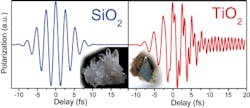In the interests of further understanding the detailed nonlinear optical responses of materials to ultrafast-laser pulses, researchers from a large group of institutions—ready, here goes: Weierstrass Institute for Applied Analysis and Stochastics (Berlin, Germany), Tampere University of Technology (Tampere, Finland), Max-Born-Institut für Nichtlineare Optik und Kurzzeitspektroskopie (Berlin, Germany), KIIT University (Bhubaneswar, India), Leibniz-Universität Hannover (Hannover, Germany), Laser-Laboratorium Göttingen (Göttingen, Germany), and Laser Zentrum Hannover (Hannover, Germany)—have now experimentally demonstrated for the first time that conditions can exist where optical harmonic generation becomes noninstantaneous. In particular, even after after the excitation stops, a noninstantaneous polarization decay may occur (depending on the material).
Analyzing third-harmonic generation in titanium dioxide (TiO2) thin films, a lifetime of 8 fs was measured—that is, noninstantaneous behavior—whereas no such process occurred in silicon dioxide (SiO2). Nevertheless, this process still qualifies as one of the fastest processes ever resolved with femtosecond spectroscopy.
Needs resonance to occur
Detailed theoretical modeling of these surprising findings indicates that this noninstantaneous response may only occur if there is a resonance of the third harmonic in the optical material. In turn, the generated material response persists in oscillating several cycles after the excitation has already ceased. Concomitantly, third-harmonic radiation is emitted. The process therefore appears like an atomic "resonance disaster" similar to what can occur in mechanical oscillators.
These findings have important consequences for femtosecond measurement techniques and possibly also for ultrashort-pulse generation. Such methods have always relied on the supposed instantaneous nature of harmonic generation and related effects. Similar avoiding resonances in mechanical systems, one therefore also has to carefully avoid optical resonances when measuring extremely short laser pulses.
Source: http://www.mbi-berlin.de/en/current/index.html#2015_02_10
REFERENCE:
1. Michael Hofmann et al., Optica (2015); http://dx.doi.org/10.1364/OPTICA.2.000151

